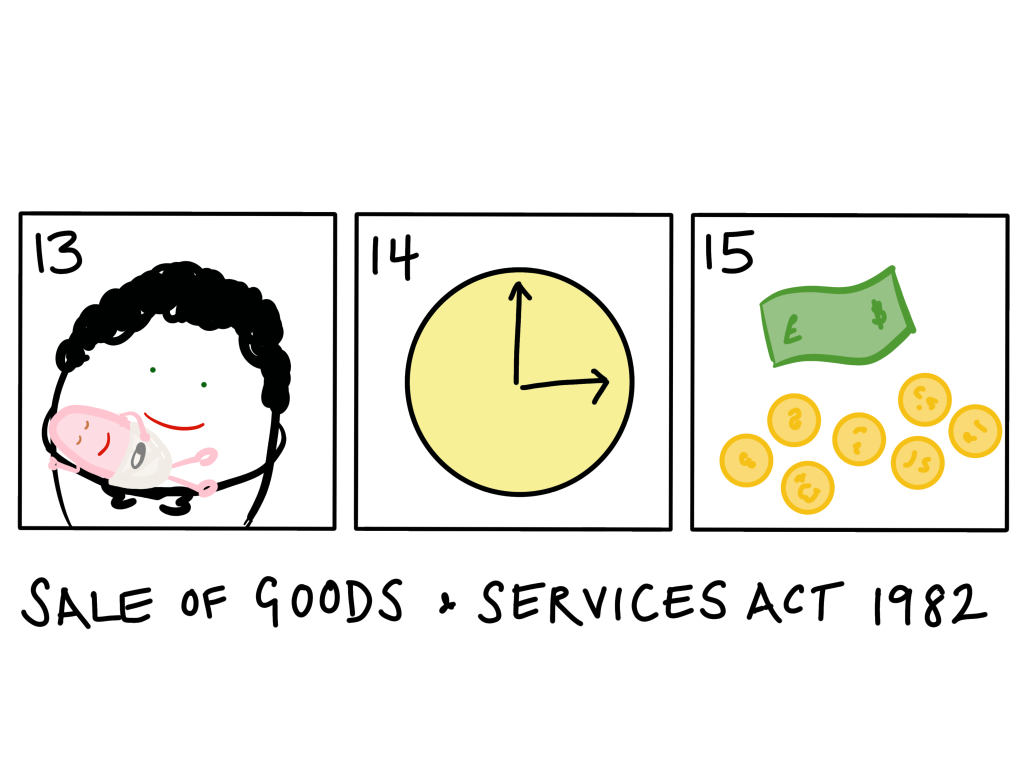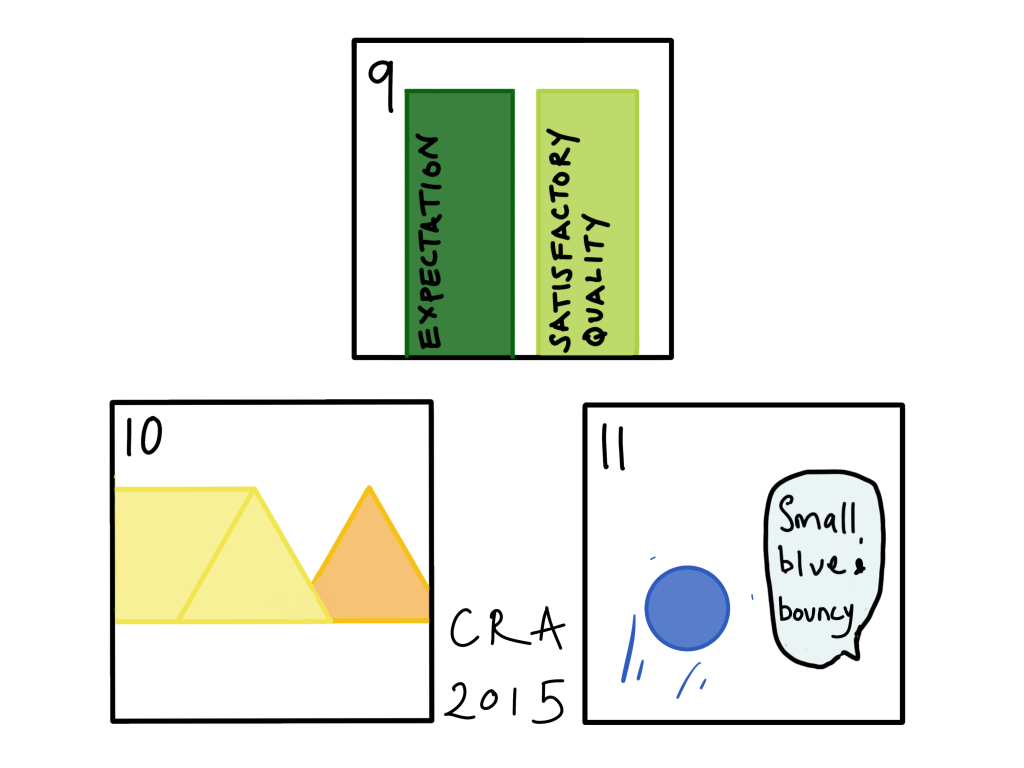JUMP TO: SALE OF GOODS ACT 1979 | SALE OF GOODS & SERVICES ACT 1982 | CONSUMER RIGHTS ACT 2015 | REVISE | TEST
IMPLIED TERMS – STATUTE
There are two Acts of Parliament, Sale of Goods Act 1979 and the Supply of Goods and Services Act 1982, which imply certain statutory terms commercial contracts. The Consumer Rights Act 2015 implies terms into consumer contracts.
SALE OF GOODS ACT 1979
This statute implies key provisions into contracts for the sale of goods. The main implied terms are; Title, Sale by Description, Quality & Fitness of Goods, Sale by Sample.

Section 12: Implied Term of Title
An implied term that the seller has the right to sell the goods, i.e. that they have a legal title in the goods and the right to sell.
Section 13: Sale by description
If goods have been sold by description there is an implied term that the goods will correspond with that description. This applies when the sale is solely by description, i.e. descriptions by mail, and online, where the customer does not see the goods initially.
In order to be a sale by description:
the description must be a term of the contract,
the description related to the identity of the goods,
the buyer relied upon the description.
Term of the Contract
In Harlingdon and Leinster Enterprises Ltd v Christopher Hull Fine Art Ltd (1991) (CoA) the claimant purchased a work of art from the defendant that was sold as being by a particular German Impressionist painter. When it turned out to be a fake the claimant could not rely on s13 because the description was not a term of the contract. The buyer had sent their own experts to examine the painting, thereby putting them in the same position as the seller to verify the authenticity of the painting. As such, the statement about the painting’s originality was merely a representation and there was no breach of the implied term that goods must match their description.
A sale may be one by description even if the goods were also seen and examined by the buyer (Beale v Taylor (1967)). In this case the defendant had offered to sell a ‘Herald, convertible, white, 1961’ and it was bought by the claimant after examination. In fact, the car was made of two parts which had been welded together and only one of the parts was from a 1961 model. However, this discrepancy was not visible to the claimant on his inspection so when he bought the car he was still relying on the description. The court held that ‘1961 Herald’ was a term and therefore part of the contract.
For more on how to determine whether the description is a term of the contract, see ‘Term or Mere Misrepresentation’.
Identity of the Goods
The description must also relate to the identity of the goods. In Ashington Piggeries v Christopher Hill Ltd (1972) (HoL) and again in Reardon Smith Line Ltd v Yngvar Hansen-Tangen and Sanko SS & Co Ltd (The Diana Prosperity) (1976) (HoL) the House of Lords found that the only descriptive words which are to be treated as the subject of s. 13 are words which identify the subject-matter of the contract.
Even if the description and the product are slightly different and the product could still technically be used by the buyer s.13 will apply as it is concerned with description and not quality. In Arcos v Ranaason (1933) (HoL) wooden staves for barrels were described as 1/2 an inch thick. When they arrived they were a fractionally different size. Even though the buyer could have used them to make barrels he was entitled to reject them because they did not precisely fit the description.
In Re Moore & Co Ltd and Landauer & Co Ltd (1921) (CoA) the buyers agreed to buy 3,000 tins of Australian canned fruit packed in cases of 30 tins. When the goods were delivered it was discovered that some of the cases contained only 24 tins, although the correct total quantity was delivered altogether. Although the arbitrator found that there was no difference in value between tins packed 30 to a case and those packed 24 to a case, the Court of Appeal held that the buyers were entitled to reject the whole consignment on the ground that there had been a breach of s. 13.
Reliance
Finally, the point of s.13 is to protect the buyer where they relied upon the description. In Harlingdon and Leinster Enterprises Ltd v Christopher Hull Fine Art Ltd (1991) (CoA) the buyer could not be said to have relied upon the description as they had sent their own experts to examine the authenticity of the painting.
Liability for s.13 is strict. This means that the buyer does not have to prove that the seller was at fault in order to obtain damages.
Section 14 SGA 1979: Quality and fitness of goods
Section 14(2) implies a term that goods sold will be of satisfactory quality.
Unlike other sections it only applies to contracts for goods sold in the course of business and not private sales. In Stevenson v Rogers (1999) (CoA) the defendant had sold his boat and then been sued for breach of the implied term of satisfactory quality. He tried to argue that he had not sold it in the course of business because his business was selling fish and not boats. However, this was rejected by the court, the sale had been made in the course of business and was closely connected to the seller’s ordinary commercial activities.
What is satisfactory quality?
Section 14(2)(a) defines satisfactory quality as the standard that a reasonable person would regard as satisfactory, taking into account all circumstances including the description of the goods and the price.
What factors affect the quality of the goods?
Section 14(2)(b) lists factors that can affect the quality of the goods beyond their general state and condition.
(a) Fitness for all the purposes for which goods of the kind in question are commonly supplied
(b) Appearance
(c) Freedom from minor defects
(d) Safety
(e) Durability
Was the buyer aware of the quality?
Section 14(2)(c) states that subsection will not apply if any matter making the quality of the goods unsatisfactory;
- was brought to the seller’s attention before the contract was made,
- the buyer examined the goods and should have noticed,
- if sold by sample, should have been apparent on an inspection of the sample.
|
Are the goods reasonably fit for that purpose?
Section 14(3) implies a term that goods sold are of a reasonable fitness for the buyer’s purpose.
The buyer must communicate, either expressly or impliedly, to the vendor their intended purpose. If a buyer intends to use goods for a normal, ordinary purpose, then this does not have to specifically mentioned to the seller, this should be assumed, but where the buyer has an unusual purpose the onus is on them to explain this to the seller. If they do not, the implied term of reasonable fitness does not apply.
The liability for breach of s.14 is strict. This means that the buyer does not have to prove that the seller was at fault, in order to obtain damages.
Section 15: Sale by Sample
Section 15(2) provides that in a contract for sale by sample there is an implied term-
(a) that the bulk will correspond with the sample in quality;
(b) that the goods will be free from any defect, making their quality unsatisfactory, which would not be apparent on reasonable examination of the sample.
REMEDIES
The terms implied by sections 12, 13, 14 and 15 are treated as conditions and not warranties meaning that the remedy for breach is termination of the contract and rejection of the goods. The claimant also has the right to sue for damages, depending on the situation and whether there is further loss.
This is only modified by s.15(a) which states that if the breach is so slight that it would be unreasonable to reject the goods then the term will be a warranty and not a condition. This does not apply to s.12 as a breach of a term as to title is always a breach of a condition.
SUPPLY OF GOODS AND SERVICES ACT 1982
This statute implies terms into contracts for services. This includes transactions like booking a holiday with a travel agent, or consulting with a solicitor for legal advice. Other situations where goods and services are combined are also covered by the Act. The act only applies to contracts in the course of business, consumer contracts for services are covered by the Consumer Rights Act 2015.
The statute is divided into two parts;
Part 1 is the supply of goods (as opposed to the sale of goods)
Part 2 is the supply of services.
Part 1
Important sections from this part are section 3 which implies a term about goods corresponding to their description (mirroring s.13 SGA) and s.4 which implies a term of satisfactory quality (mirroring s.14 SGA).
Part 2

Section 13: Reasonable Care & Skill
Section 13 implies a term that any supplier of services will carry out that service with reasonable care and skill.
This statutory duty to use reasonable care and skill is commensurate to the common law duty in the tort of negligence. Breach of this implied term will amount to a breach of contract, and the same remedies apply.
Section 14: Reasonable time
Section 14(1) implies a term that the service will be carried out within a reasonable time. This only applies if the time for the service is not fixed by the contract, left to be fixed in a manner agreed by the contract, or determined by the course of dealings between parties.
Section 15: Reasonable Consideration
Section 15(1) implies a term that the buyer will pay a reasonable charge for the services provided. This only applies if the consideration for the service is not fixed by the contract, left to be fixed in a manner agreed by the contract, or determined by the course of dealings between parties.
Where contracts solely for the supply of service, only s.13, s.14 and s.15 apply.
Where the contract includes the provision of goods, then s.3 and s.4 also apply.
CONSUMER RIGHTS ACT 2015
The Consumer Rights Act 2015 was passed with the objective of implementing ‘a simple, coherent framework of consumer legislation by consolidating and simplifying existing law’.
Many of the sections mirror the SGA and SGSA but specifically for B2C rather than B2B contracts.
Consumer
A ‘consumer’ is defined in s.2(3) as:
‘An individual acting for the purposes that are wholly or mainly outside that individual’s trade, business, craft or profession’.
Trader
A ‘trader’ is defined, in s.2(2) as:
‘A person acting for purposes relating to that person’s trade, business, craft, or profession, whether acting personally or through another person acting in the trader’s name or on the trader’s behalf’.
Section 9 – Goods of satisfactory quality

This mirrors s.14 SGA 1979.
Section 9(2) defines satisfactory quality as the standard that a reasonable person would regard as satisfactory, taking into account all circumstances including the description of the goods and the price.
What factors affect the quality of the goods?
Section 9(3) lists factors that can affect the quality of the goods beyond their general state and condition.
(a) Fitness for all the purposes for which goods of the kind in question are commonly supplied
(b) Appearance
(c) Freedom from minor defects
(d) Safety
(e) Durability
Was the buyer aware of the quality?
Section 9(4) states that subsection will not apply if any matter making the quality of the goods unsatisfactory;
- was brought to the seller’s attention before the contract was made,
- the buyer examined the goods and should have noticed,
- if sold by sample, should have been apparent on an inspection of the sample.
|
Section 10 – Goods fit for purpose
This corresponds to s.14(3) SGA 1979.
Section 10(3) implies a term that goods sold are of a reasonable fitness for the buyer’s purpose.
The buyer must communicate, either expressly or impliedly, to the vendor their intended purpose. It does not matter if that was the usual purpose for which the goods are used (s.10(3)).
This section does not apply if the consumer didn’t rely, or it is unreasonable for them to rely, on the skill or judgment of the trader.
Section 11 – Goods to be as described
This corresponds to s.13 SGA 1979.
Section 11(1) – If goods have been sold by description there is an implied term that the goods will correspond with the description.
Section 11(2) – If the sale is by sample and description it is not sufficient for the bulk of the goods matches the sample if the goods do not also match the description.
Even if the description and the product are slightly different and the product could still technically be used by the buyer s.13 will still apply as it is solely concerned with description and not quality.











